Common Cricket Injuries & How to Prevent Them
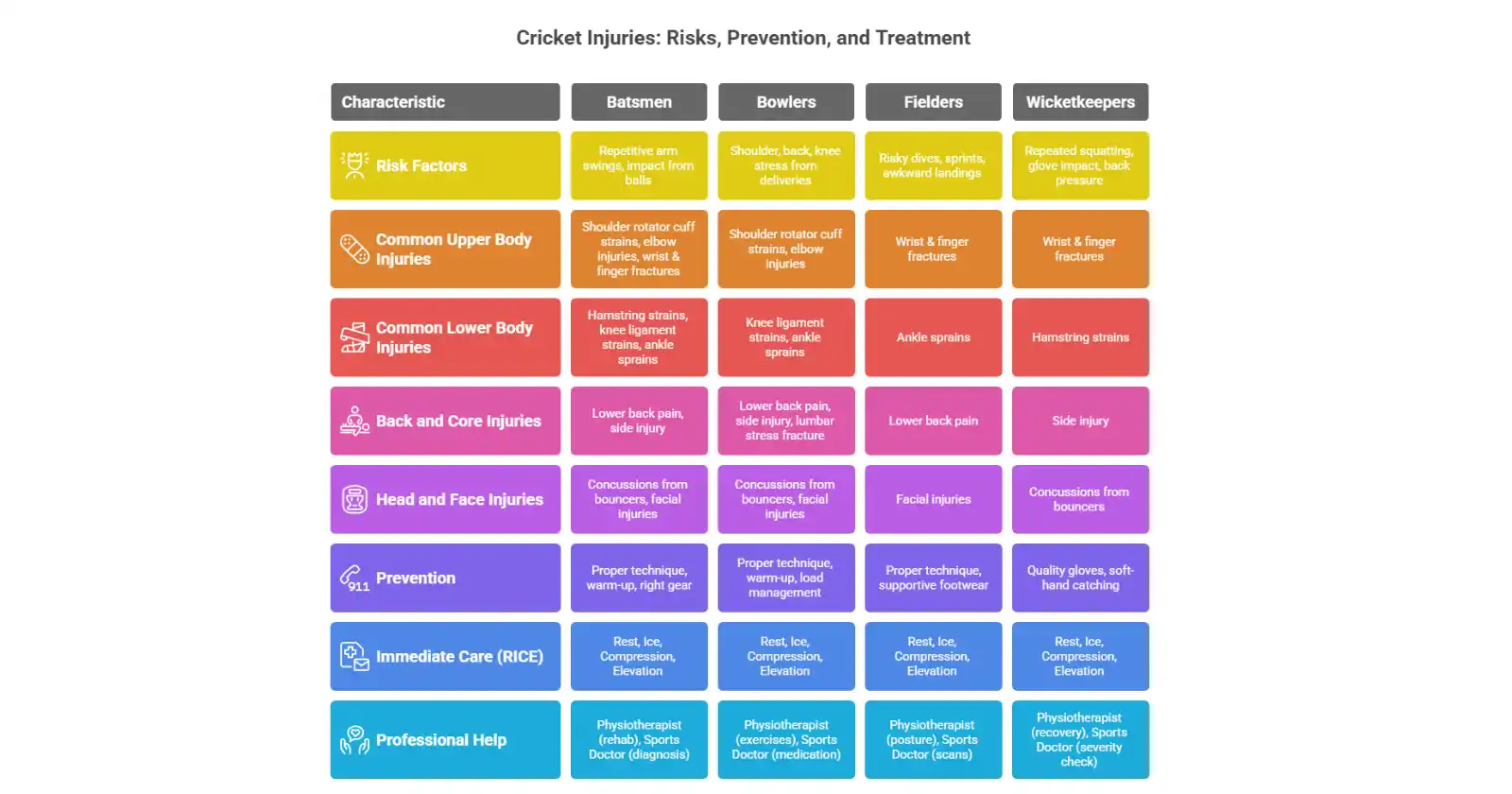
Ever tried diving like Dhoni and ended up limping like your grandpa? Yeah, cricket injuries are real. Let’s talk about the usual sprains, strains and bruises. Don’t worry, I promise to keep it helpful.
Why Injuries Are Common in Cricket?
Cricket may not be full-contact. Here’s why injuries are so common:
- Bowling and batting improper movements
- Sudden Movements
- Long Playing Duration
- Poor Warm-up/Cool-down
- Hard Equipment and Surfaces
- Improper Technique
Who’s Most at Risk?
Each cricketer does different movements, players at risk of getting hurt. Here’s a breakdown:
| Role | Why They’re at Risk |
| Batsmen | Repetitive arm swings, risk of impact injuries from fast balls. |
| Bowlers | High shoulder, back and knee stress from repeated deliveries. |
| Fielders | Risky dives, sudden sprints and awkward landings cause sprains. |
| Wicketkeepers | Repeated squatting, glove impact, finger jams and back pressure from posture. |
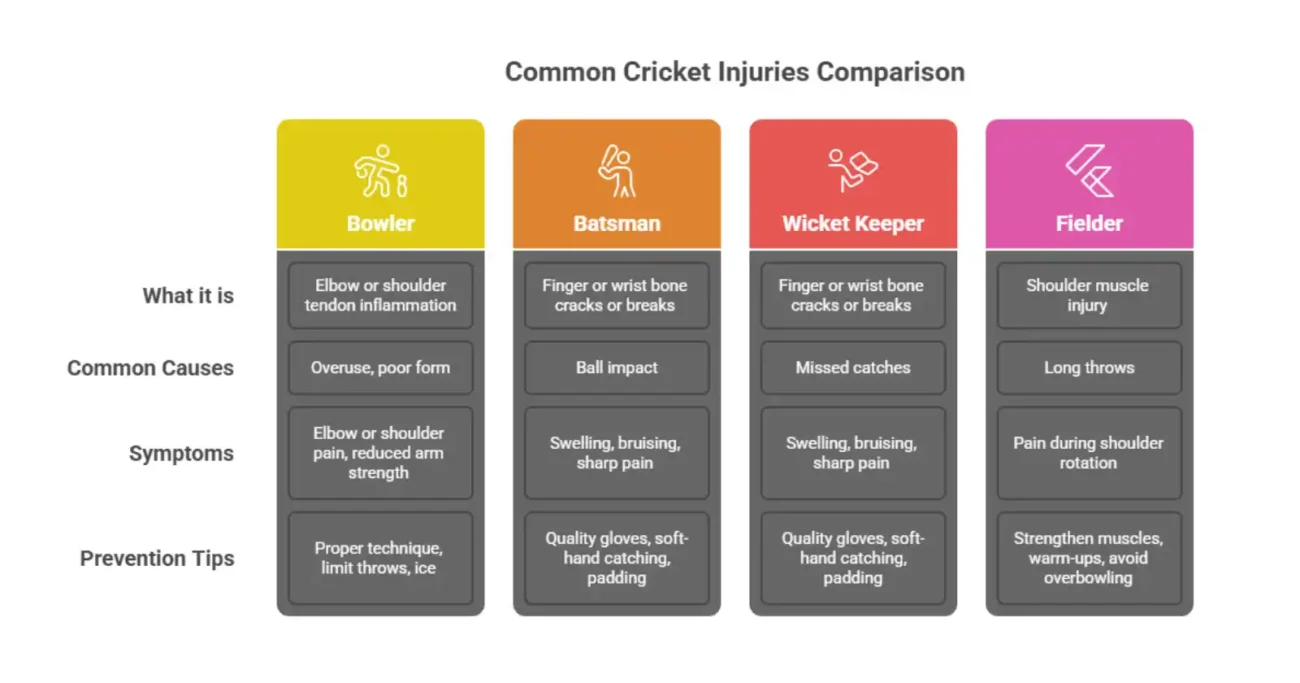
Types of Common Cricket Injuries
Let’s zoom in on the most frequently seen injury types in cricket, especially focusing on upper body injuries here.
Upper Body Injuries
Upper body injuries are especially common among bowlers, batsmen and wicket keepers. They typically face overuse, poor form or sudden hurt.
Shoulder Rotator Cuff Strains
What it is: An injury to the rotator cuff muscles that hold the shoulder joint together.
Common in: Fast bowlers. Fielders who do long throws.
Symptoms: Pain during shoulder rotation. Weakness in arm.
Prevention Tips: Strengthen shoulder muscles with resistance bands. Don’t skip warm-ups. Avoid overbowling in practice.
Elbow Injuries (e.g. Thrower’s Elbow)
What it is: Tennis elbow is when the tendons in your arm get inflamed or damaged from overuse.
Common in: Fast bowlers. Players who throw frequently without proper mechanics.
Symptoms: Pain on the inner or outer elbow. Reduced arm strength. Stiffness or tingling.
Prevention Tips: Use proper throwing technique. Limit excessive long throws during practice. Ice elbows.
Wrist & Finger Fractures
What it is: Cracks or breaks in the wrist and finger bones, that usually happen when a ball hits them.
Common in: Wicketkeepers (missed catches or awkward takes). Batsmen (hit by fast deliveries). Fielders (ball hitting fingers while catching).
Symptoms,
- Swelling
- Bruising
- Inability to move fingers properly
- Sharp pain
Prevention Tips,
- Wear quality gloves (especially for keepers)
- Practice soft-hand catching techniques
- Don’t shy away from protective padding
Lower Body Injuries
What it is: Injuries at the back of the leg are commonly caused by overstretching or running.
Common Causes: Sudden sprinting between wickets. More running while fielding. Poor flexibility or lack of warm-up.
Symptoms,
- Sharp pain in the back of the thigh.
- Swelling.
- Inability to fully stretch the leg.
How to Reduce Risk,
- Warm-up with leg movements.
- Include strengthening exercises (e.g. Nordic curls).
- Avoid overexertion, especially in cold conditions.
Knee Ligament Strains
What it is: Twisting or landing awkwardly might cause ACL or MCL injury.
Common Causes,
- Quick direction changes while fielding.
- Awkward landings after dives or jumps.
- Poor balance and joint control.
Symptoms,
- Knee pain and swelling.
- Instability or “wobbly” feeling in the knee.
- Limited range of motion.
How to Reduce Risk,
- Strengthen leg muscles (quads, hamstrings, calves).
- Use supportive footwear with proper grip.
Ankle Sprains
What it is: Twisting or rolling the foot causes ankle ligament stretching or tears.
Common Causes,
- Running on uneven surfaces.
- Poor landing technique.
- Slippery or unstable field conditions.
Symptoms,
- Sudden pain and swelling in the ankle.
- Limited movement.
- Tenderness around the joint.
How to Reduce Risk,
- Use ankle-supporting cricket shoes.
- Perform ankle mobility and strengthening exercises.
- Tightly tape the ankle if there’s a history of injury.
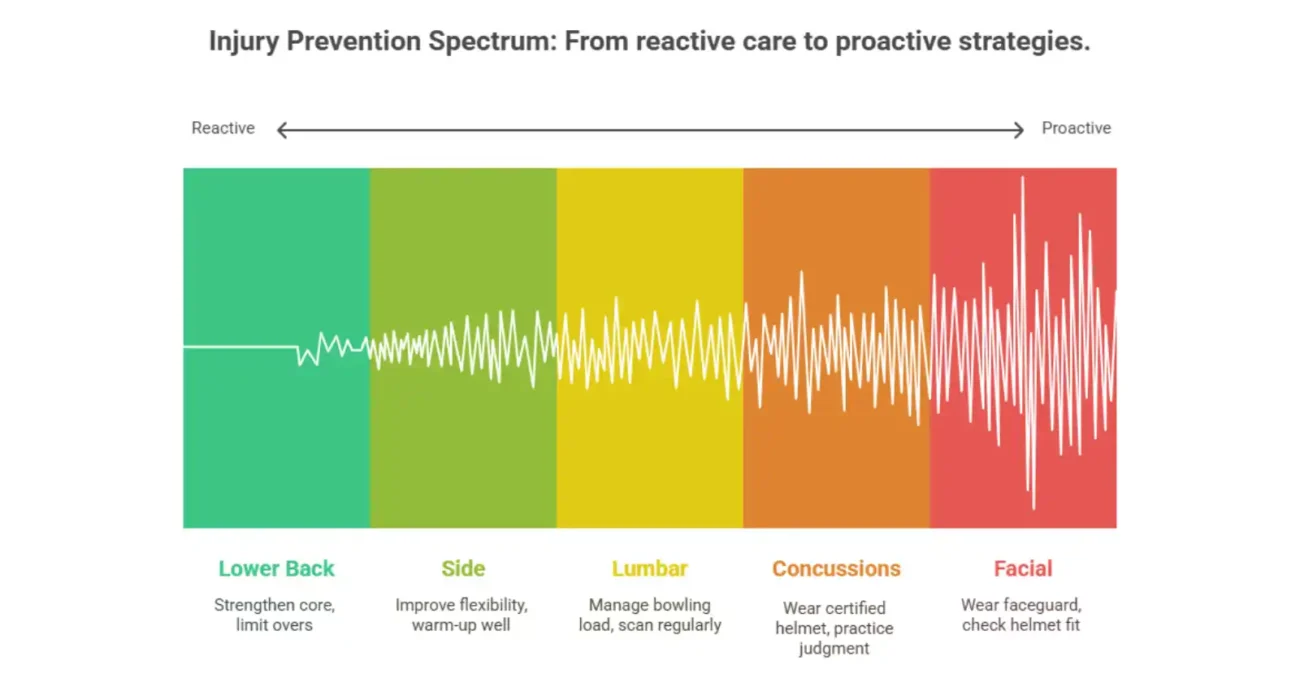
Back and Core Injuries Cause & Reduce Ways
Back injuries are especially common among fast bowlers.
| Injury Type | Cause | Reduction/Prevention |
| Lower Back Pain | Overbowling, poor posture, weak core | Strengthen core muscles (planks, bridges), limit overs, proper bowling technique |
| Side Injury | Over-rotation during bowling or batting | Improve flexibility, warm-up with trunk twists, reduce explosive unprepared movements |
| Lumbar Stress Fracture | Continuous high-impact bowling, especially in youth | Strict bowling load management, regular scans for young bowlers |
General Back Care Tips,
- Must do core workouts in training.
- Avoid sudden twisting without warm-up.
- Maintain good posture while sitting or lifting gear.
Head and Face Injuries
Concussions from Bouncers
What it is: A mild traumatic brain injury caused by a ball impact, usually when hit by a bouncer.
Common Causes,
- Improper batting stance.
- Lack of or ill-fitted helmet.
- Misjudging ball bounce or pace.
Symptoms,
- Headache, dizziness or blurred vision.
- Confusion or memory issues.
- Nausea or vomiting.
How to Reduce Risk,
- Always wear a certified helmet.
- Practice bouncer judgment in nets.
- Don’t play hook shots without confidence.
Note: Treat headaches carefully and see a doctor quickly.
Facial Injuries Due to Missing Helmets
What it is: Rapid bowlers or helmetless fielding might cause facial cuts, fractures or bruising.
Common Causes,
- Not wearing a helmet in nets or casual games.
- Short-pitched deliveries hitting unprotected areas.
- Poorly fitted helmets or broken grills.
Symptoms,
- Facial swelling or visible injury.
- Bleeding, nose fractures, dental damage.
- Possible vision issues if near eyes.
How to Reduce Risk,
- Always wear a helmet with a faceguard when batting or close fielding.
- Regularly check helmet condition and fit.
- Encourage juniors to wear full protective gear even during practice.
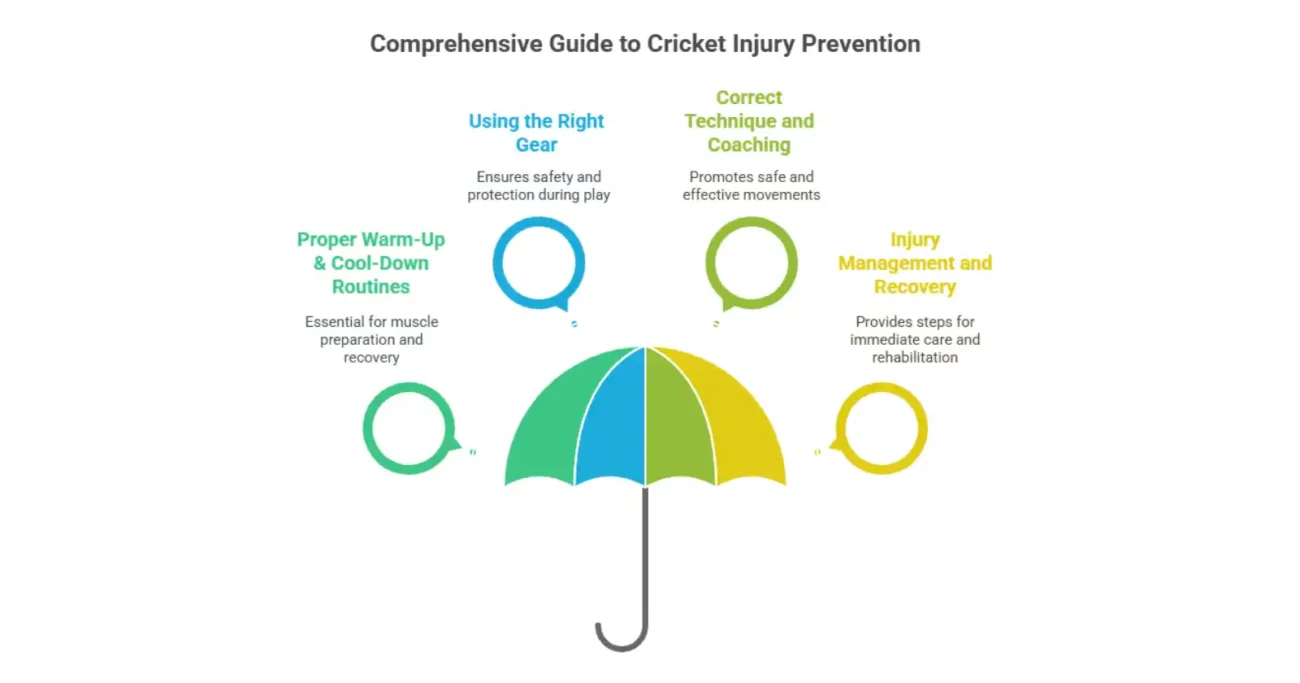
Causes Behind These Injuries
Poor Technique or Form
Incorrect movements during the match are one of the main causes of cricket injuries. When you bowl with bad technique, your shoulders and back can get hurt. Improper batting style can cause side strains and wrist injuries. Fielding without proper posture causes knee or ankle injuries.
Lack of Conditioning and Warm-Up
Jumping straight into the game without prepping the body isn’t good at all. Skipping warm-up exercise causes muscles and limited joint mobility. No cool-down after games or training causes tight muscles and poor recovery. Untrained players or weekend warriors often ignore basic fitness preparation.
Sample Warm-Up (10–15 mins):
| Exercise | Duration | Purpose |
| Light Jogging | 3-5 mins | Increases body temperature |
| Arm & Shoulder Circles | 1-2 mins | Loosens upper body joints |
| Dynamic Stretching | 5 mins | Improves range of motion |
| Practice Movements | 3 mins | Match-specific muscle memory |
Overuse and Repetitive Motion
Overdoing it without proper rest causes injuries. Fast bowlers are most prone. Too many net sessions or matches without recovery time stresses joints. Overuse injuries like shin splints, back pain and elbow strain.
How to Prevent Cricket Injuries?
Proper Warm-Up & Cool-Down Routines
Warm up to increase blood flow, loosen muscles and improve coordination. Cool down to gradually lower heart rate, remove lactic acid buildup and faster recovery. Use foam rollers or light stretches post-game.
Cool-Down Routine Ideas,
Light jogging or walking (5 mins). Static stretching (hamstrings, quads, shoulders, back- 1 min each). Deep breathing to relax the nervous system.
Using the Right Gear (Helmets, pads, gloves, shoes)
Protection isn’t just for style, it saves bones. Always use well-fitted, high-quality gear. Replace worn-out items to avoid safety issues.
| Equipment | Purpose |
| Helmet | Prevents head injuries from fast balls |
| Pads | Protect knees, shins, and thighs from impact |
| Gloves | Shield fingers and palms from fractures |
| Shoes | Provide grip, ankle support, and reduce slips |
Correct Technique and Coaching Rules & Regulation To Avoid Injuries
Technique beats raw power every time.
- Proper coaching builds safe and effective movements.
- Batting with the right stance and swing protects your wrists and back.
- Bowling with correct arm rotation and run-up form reduces spine and shoulder load.
- Fielding exercises teach safe diving, catching and landing techniques.
Injury Management and Recovery
What to do when it still happens,
Immediate Care (RICE Method)
| Step | Action |
| Rest | Stop activity immediately |
| Ice | Apply ice pack for 15–20 mins |
| Compression | Use bandage to reduce swelling |
| Elevation | Raise the injured area if possible |
Recovery Tips
- Visit a sports physio if pain stays longer beyond 48 hours.
- Rehabilitation exercises help rebuild strength and flexibility.
- Don’t rush, attend matches when pain-free and doctor-approved.
- Use injury time to train other areas safely.
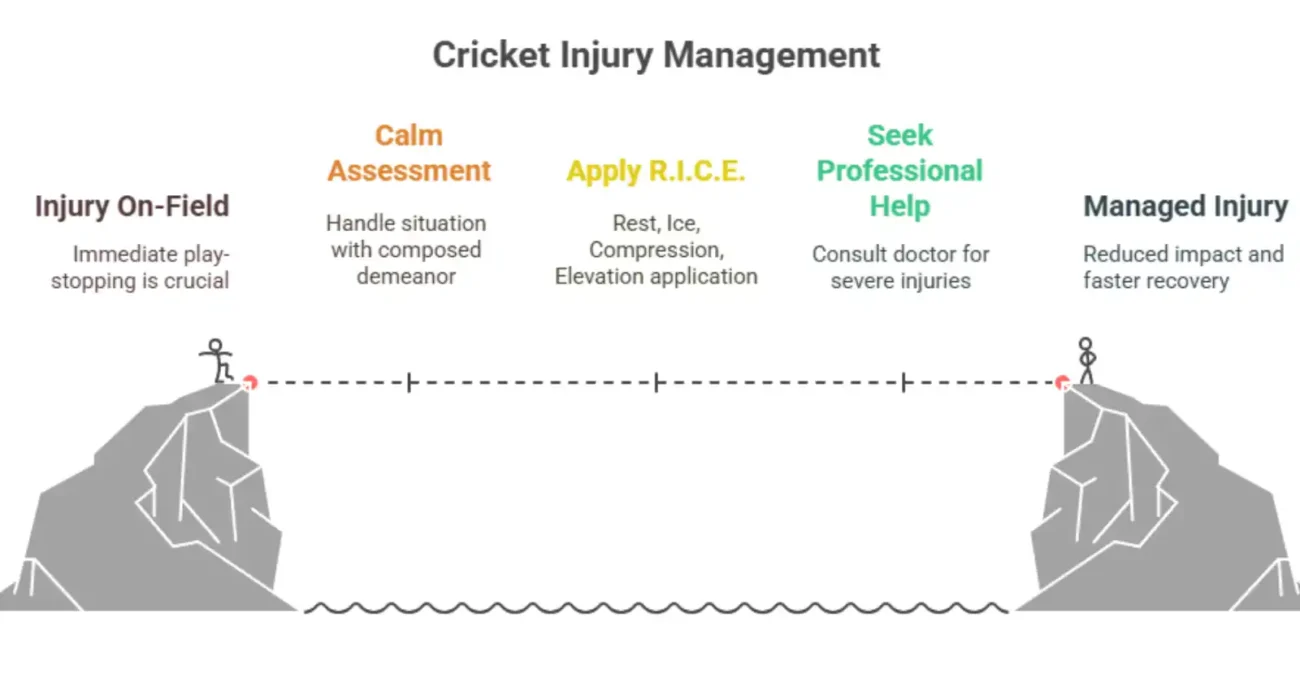
What to Do When Injuries Happen?
When you get injured in Cricket, quick and appropriate treatment can save time and long-term impact. Here’s what players, coaches or even teammates should do:
Stop play immediately: Don’t “walk it off” or keep playing.
Handle the situation calmly
Apply first aid: Use the R.I.C.E. method (explained below).
Seek help if needed: Don’t hesitate to call for professional medical support or ambulance.
First Aid & On-Field Treatment
First 15-30 minutes of first aid plays a big role in the post-injury. Here’s the golden standard:
R.I.C.E. Method Table
| Component | Description | What to Do |
| Rest | Stop any movement to avoid further injury | Get the player to sit or lie down |
| Ice | Reduces swelling & numbs pain | Apply a cold pack (wrapped in cloth) for 15-20 min |
| Compression | Prevents excessive swelling | Use a bandage to wrap around the injury (not too tight) |
| Elevation | Reduces blood flow to injured area | Raise the injured limb above heart level |
Additional First Aid Tips
Don’t apply heat in the first 48 hours. Never pop blisters or try to “reset” dislocated joints. If unconscious or bleeding from the head, treat it at a medical emergency.
A Physiotherapist or Sports Doctor
When injuries are more than just minor bruises or sprains, professional help is a must.
Signs You Need to See a Physio or Sports Doctor
- Persistent swelling or pain after 48 hours
- Limited movement or weakness in the limb
- Clear deformity (e.g. twisted finger or bent wrist)
- Repeated injuries in the same area
- You’re unsure if it’s safe to resume playing
Difference Between the Two
| Specialist | Role | Best For |
| Physiotherapist | Rehab, exercises, posture correction | Muscle tears, joint recovery, post-surgery |
| Sports Doctor | Diagnosis, medication, scans | Fractures, concussions, injury severity check |
Real Stories & Pro Tips from Cricketers
“I tore my hamstring mid-innings and thought it was just a cramp. Ended up out for two months. Never skip the warm-up, even if you’re late!”
Amit Sharma, Domestic League Player
Always stretch. Use foam rollers post-match to reduce soreness. Don’t rely on painkillers.
Injury in Club Matches
“Our wicketkeeper dived for a wide one, missed and headbutted the stumps. Luckily, it was just a bruise but we started calling him ‘Goalkeeper’ after that!”
“Tried to bowl a doosra after watching a YouTube video. Pulled my shoulder and got hit for six. Injury + humiliation combo.”
At The End
Injuries might be part of the game. With a little prep, some stretches and less “hero dives,” you can stay fit. So, get your gear ready? What’s your weirdest cricket injury story of yours? Let’s hear it in the comments.
FAQs
What are the most common cricket injuries?
Muscle strains, ankle sprains, finger fractures and lower back pain are at the top of the list.
How can I prevent cricket injuries?
Warm up properly, wear protective gear and avoid overtraining.
Are junior players more prone to injuries?
Yes, especially from poor technique and lack of training.
What should I do after a cricket injury?
Use RICE: Rest, Ice, Compression, Elevation, then see a doctor if needed.
Can stretching help reduce injuries?
Yes, Regular stretching improves flexibility and reduces muscle strain risk.

This article is a cricket players essential survival guide, hilariously proving that wearing pads isnt just for looking tough – its a sound investment in avoiding a career-ending dance-off with limping! While never skip the warm-up rings a bell (right after always wear a helmet), its the RICE method that truly steals the show – like the ultimate lazy day recovery plan: Rest, Ice, Compress… and eventually Evade responsibility by seeking help. Kudos for the physio vs. sports doc breakdown – now we know who to call when we accidentally try to catch a bouncer bare-handed!
Haha, love your take! 😄 You’ve perfectly captured the struggle of staying injury-free while still looking ‘tough on the pitch.’ I’m glad the RICE method and the physio vs. sports doc breakdown resonated — it’s amazing how a little preparation can save a career (and some dignity!). Thanks for sharing your thoughts — I’ll keep more practical and slightly hilarious survival tips coming, so stay tuned!